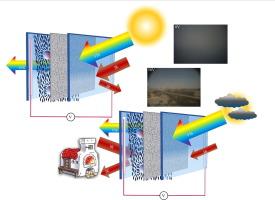Hybrid smart window for visibility control and heat blocking utilizing NMP-LC liquid crystal tunable scattering mode with nanostructured VO2 metasurface
IF 6.9
2区 材料科学
Q2 CHEMISTRY, PHYSICAL
引用次数: 0
Abstract
A hybrid smart window is demonstrated by integrating vanadium dioxide (VO2) nanostructured thin film (nSTF), prepared using oblique angle deposition, with a liquid crystal (LC) doped with nanoporous microparticles (NMP-LC mode). The device exhibits a non-reciprocal effect due to its asymmetric nature involving absorption and scattering layers, where the thermochromic performance is superior when the VO2 side faces outward. Although the thermochromic properties of VO2 are slightly reduced during device integration, the infrared (IR) blocking capability is enhanced. When the VO2 side faces outward, the device achieves TIR ∼ 19 % and RIR ∼ 52 %, compared to TIR ∼ 17 % and RIR ∼ 41 % when the LC side faces outward. This IR blocking, achieved through reflection and absorption, mimics the effect of an insulating layer, contributing to energy savings. The LC, enriched with nanoporous microparticles, exhibits a tunable scattering effect that allows dynamic control of visible light transparency. Additionally, the VO2 nSTF aligns the LC and functions as an electrode, lowering production costs. The optical properties of the VO2 nSTF are modeled using the anisotropic Bruggeman formalism and the 4 × 4 matrix formalism. The transmission and reflection characteristics in the non-scattering state agree well with experimental observations for both the VO2 nSTF and the full device. However, in the scattering state, while general trends are captured, quantitative agreement requires more rigorous scattering models. The operation voltage is found to decrease when the frequency is reduced, hence reducing the required operation power by more than an order of magnitude. The integration of the two materials, VO2 and NMP-LC, enhances the functionality of smart windows, advancing their potential for achieving near-zero energy solutions.


基于纳米结构VO2超表面的NMP-LC液晶可调散射模式的能见度控制和热阻挡混合智能窗口
将斜角沉积法制备的二氧化钒(VO2)纳米结构薄膜(nSTF)与掺杂纳米孔微粒的液晶(LC) (NMP-LC模式)集成在一起,形成了一种混合智能窗口。由于其吸收和散射层的不对称性质,该器件表现出非互易效应,其中当VO2面朝外时,热致变色性能更好。虽然VO2的热致变色性能在器件集成过程中略有降低,但红外(IR)阻挡能力增强。当最大侧脸向外,设备达到行动 ∼ 19 %和RIR ∼ 52 %,相比行动 ∼ 17 %和RIR ∼ 41 %时LC侧脸向外。这种通过反射和吸收实现的红外阻挡,模拟了绝缘层的效果,有助于节省能源。LC富含纳米多孔微粒子,具有可调的散射效应,可以动态控制可见光透明度。此外,VO2 nSTF对准LC并作为电极,降低了生产成本。采用各向异性Bruggeman形式和4 × 4矩阵形式对VO2 nSTF的光学性质进行了建模。在非散射状态下,VO2 nSTF和全器件的透射和反射特性与实验观测结果吻合较好。然而,在散射状态下,虽然捕获了一般趋势,但定量一致需要更严格的散射模型。当频率降低时,工作电压降低,因此所需的工作功率降低了一个数量级以上。VO2和NMP-LC两种材料的集成增强了智能窗户的功能,提升了它们实现近零能耗解决方案的潜力。
本文章由计算机程序翻译,如有差异,请以英文原文为准。
求助全文
约1分钟内获得全文
求助全文
来源期刊

Applied Surface Science
工程技术-材料科学:膜
CiteScore
12.50
自引率
7.50%
发文量
3393
审稿时长
67 days
期刊介绍:
Applied Surface Science covers topics contributing to a better understanding of surfaces, interfaces, nanostructures and their applications. The journal is concerned with scientific research on the atomic and molecular level of material properties determined with specific surface analytical techniques and/or computational methods, as well as the processing of such structures.
 求助内容:
求助内容: 应助结果提醒方式:
应助结果提醒方式:


